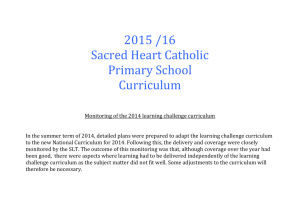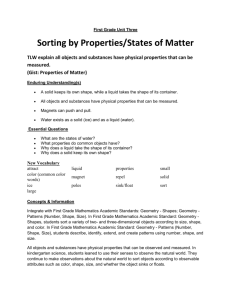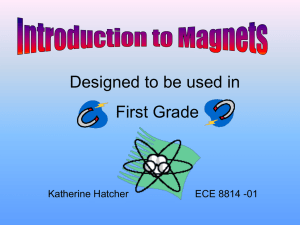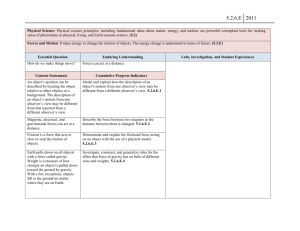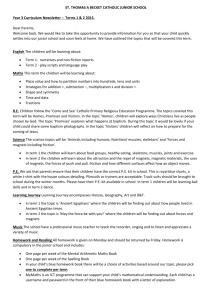Will It Attract or Repel?
advertisement
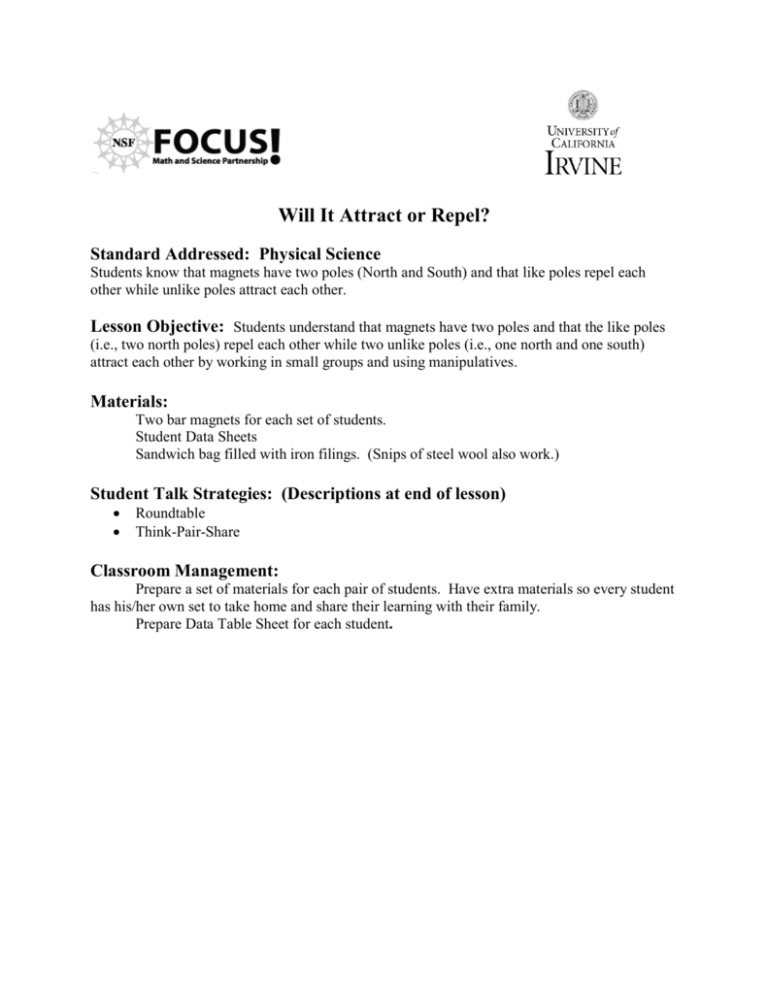
Will It Attract or Repel? Standard Addressed: Physical Science Students know that magnets have two poles (North and South) and that like poles repel each other while unlike poles attract each other. Lesson Objective: Students understand that magnets have two poles and that the like poles (i.e., two north poles) repel each other while two unlike poles (i.e., one north and one south) attract each other by working in small groups and using manipulatives. Materials: Two bar magnets for each set of students. Student Data Sheets Sandwich bag filled with iron filings. (Snips of steel wool also work.) Student Talk Strategies: (Descriptions at end of lesson) Roundtable Think-Pair-Share Classroom Management: Prepare a set of materials for each pair of students. Have extra materials so every student has his/her own set to take home and share their learning with their family. Prepare Data Table Sheet for each student. ENGAGE: Connect to Prior Knowledge and Experience, Create Emotionally Safe Learning Environment, Preview New Vocabulary Teacher’s Role Teacher Questions Review of vocabulary: attract; repel; poles, magnetic field Roundtable: Each student contributes one idea about what he or she thinks “attract” and “repel” mean and how he/she will remember the meaning of each word. . How can we remember that attract means go together and repel means push away? Estimated time: 10 minutes Students’ Role Students review vocabulary in a 4 person Roundtable group. After teacher ascertains that the students have the right meaning of the vocabulary. Possible student responses: Repel: push away. If you have a friend who wants to be just like you, wear your clothes that you want to wear, eat your food, use your toys that you’re playing with all the time you wouldn’t like it – you would push them away or repel them. Attract: You are attracted to friends that are slightly different from you – you share toys, you eat your own food – even though you share it, you are attracted to them – you want to be with them. Students prepare foldable to help them remember the vocabulary necessary for the science concept. EXPLORE: Hands-On Learning, Contextualize Language, Use of Scaffolding (Graphic Organizers, Thinking Maps, Cooperative Learning), Use of Multiple Intelligences, Check for Understanding Estimated time: 15 minutes Teacher’s Role Teacher Questions Students’ Role Teacher gives each group of students two bar magnets for them to explore how the poles of the magnets interact with each other. Are the two ends of the magnets the same? Students converse with their groups (or partner) as they discuss the answers to the teacher’s questions. When you put two magnets together at the poles, what happened? They grabbed each other because they were attracted to each other. They pushed against each other and I couldn’t put them together. Students will also investigate How far away does the The closer the magnet is to the the magnetic field by using the magnet have to be to pull the filings, the stronger the magnets and a sandwich bag iron filings towards it? magnetic field is. If the filled with iron filings. magnet is further away, the . pull is not as strong. EXPLAIN: Listening, Speaking, Reading, and Writing to Communicate Conceptual Understanding Estimated time: 20 minutes Teacher’s Role Teacher Questions Students’ Role Teacher finds out what students think after doing the Explore. Think, Pair, Share: Students first think on their own then pair with the person next to them before sharing with the whole class. Students will participate in a Think, Pair, Share in answer to the teacher’s questions. After students think and share with each other, the teacher will call on random students to share orally. What is a magnetic field? An area where the magnet has the ability to pull something to it. The strength of the field tells how well the magnet pulls metal things toward it. What is force? Force is like making someone do something. Magnets make another magnet move to it. Do all magnets have a north and south pole? All magnets have to have two poles. What about circle magnets? Circle magnets still have two poles. How do you know that you have one north and one south pole together? If the two poles attract to each other, they are north and south poles. How do you know if the poles are the same? If they push each other away, they are either both north poles or both south poles. What do you think will All magnets must have a north happen if you break a magnet and south pole – so if you in half? Will it still be a break a magnet in half, each complete magnet with a north half will have both a north and and a south pole? Or will it a south pole. not work any longer? EVALUATE: Thinking Maps, Summarize Lesson and Review Vocabulary, Variety of Assessment Tools, Games to Show Understanding Estimated time: 20 minutes Teacher’s Role Teacher Questions Students’ Role Teacher asks students to describe what happens when the north pole of a magnet approaches the north pole of the other magnet and what happens when the south pole of a magnet approaches the north pole of the other magnet as well as other combinations of interactions. Please describe what happens when the north pole of one magnet approaches the south pole of another magnet. Students will participate in a Roundtable discussion prior to completing a circle map defining their knowledge of magnetic forces. Teacher will have students Please describe what happens complete a circle map defining when the north poles of two magnets and including the magnets approach each other. words magnetic field, north and south poles, attract, repel, etc. Students in small groups will prepare a skit demonstrating the basic knowledge that 1. Like poles repel, 2. Unlike poles attract, 3. The closer the magnet is to the iron filings, the stronger the force. They may use drama or charades. EXTEND: Group Projects, Plays, Murals, Songs, Connections to Real World, Connections to Other Curricular Areas Estimated time: 20 minutes Teacher’s Role Teacher extends the lesson to show students how magnets attract small iron particles in dirt or some kinds of cereals. Teacher and students read the “Magnet Chant”. Teacher Questions Students’ Role Students will complete a twoparagraph writing summarizing their learning. They will write one paragraph from the 1st person point of view and the other paragraph from the 3rd person point of view (their friend). They may come from a pole point of view, the magnet point of view, the filings point of view, etc. Student Talk Strategies Adapted from Avenues, Hampton Brown, 2007. Design Roundtable Think, Pair, Share Description Teacher seats students in small groups around tables. Teacher asks a question with many possible answers. Each student around the table answers the question a different way. Benefits and Purposes Encouraging elaboration creates appreciation for diversity of opinion and thought. Eliciting multiple answers enhances language fluency. Students think about a topic suggested by the teacher. Pairs discuss the topic. Students individually share information from their discussion with the class. The opportunity for self-talk during the individual think time allows for the student to formulate thoughts before speaking. Think time allows students to think about the concepts and the language before producing. Discussion with a partner reduces performance anxiety and enhances understanding. Teacher Background Knowledge A magnetic field is the region where a magnetic force can be detected. Magnets exert forces on one another. They are similar to electric charges, for they can both attract and repel without touching one another, depending on which ends of the magnets are held near one another. Like electric charges also, the strength of their interaction depends on the distance of separation of the two magnets. Whereas electric charges produce electrical forces, regions called magnetic poles produce magnetic forces. The iron filings in the investigation enable the students to see the magnetic forces as magnetic field lines. Unlike electric charges, magnets do not have + and – ends. This is a common misconception. Students will often say the magnet has a + end when they refer to the North pole and they will say that the magnet has a – end when they refer to the South pole. But magnets do not have + and – ends. The end that points northward is called the “north-seeking pole”, and the end that points southward is called the “south-seeking pole”. More simply, these are called the “North and South poles”. All magnets have both a north and a south pole. For a simple bar magnet, these are located at the two ends. The common horseshoe magnet is a bar magnet that has been bent, so its poles are also at its two ends. If the north pole of one magnet is brought near the north pole of another magnet, they repel. The same is true of a south pole near a south pole. If opposite poles are brought together, however, attraction occurs. Like poles repel; opposite poles attract. Magnetic poles behave similarly to electric charges in some ways, but there is another very important difference. Whereas electric charges can be isolated, magnetic poles cannot. A north magnetic pole never exists without the presence of a south pole, and vice versa. The north and south poles of a magnet are like the head and tail of the same coin. If you break a bar magnet in half, each half still behaves as a complete magnet. Resources Thinking maps - http://thinkingmaps.org/ What is a magnet? - http://www.dowlingmagnets.com/about_magnets.php Magnet facts - http://buymagnets.com/faq/ Magnet resources – http://www.internet4classrooms.com/science_elem_magnets.htm http://www.explainthatstuff.com/magnetism.html Will It Attract or Repel? Prior Knowledge: What do you think of when you hear the words: attract repel poles Question: Are the two ends of magnets the same? Prediction: I think that because . Procedure: 1. 2. 3. 4. 5. 6. 7. 8. Put the two bar magnets pointing toward each other. Record your observations in the data table. Switch one of the ends and observe what happens. Place the bag of iron filings over the 2 magnets. In the data table, draw what you see inside the bag. Now put the two bar magnets side by side. Place the bag of iron filings over the 2 magnets. In the data table, draw what you see inside the bag. Data Table: Magnets Observations (draw what you see in the bag) magnets pointing toward each other magnets side by side Claims and Evidence: (adapted from the California Reading and Literature Project “Focused Approach”) Beginning: Students demonstrate comprehension by pointing to correct object or producing one or two word responses. Early Intermediate: simple sentences with past and present progressive verb tense The like poles of the magnets . The unlike poles of the magnets . Intermediate: simple and compound sentences with a variety of verb tenses and descriptive adverbs The like poles of the magnets , but the unlike poles . Early Advanced: compound sentences with adverbial clauses telling how, where, or when After , the two magnets . Magnets Chant by Carol Allen and Susan Isaksen Capistrano Unified School District Magnets here Magnets there Magnets, magnets everywhere. Like poles repelling. Unlike poles attracting. Electromagnets generating, And horseshoe magnets influencing. Magnets in different shapes, Magnets on refrigerators, Magnets with north and south poles, And magnets in our brains! Magnets here, Magnets there, Magnets, magnets everywhere. Magnets! Magnets! Magnets!


